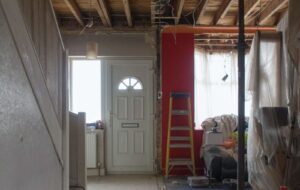
Step into the world of architectural marvels, where creativity knows no bounds and innovation reigns supreme. In a time when homes have become more than just a shelter, the visionary Modern Home Architects of today have taken the concept of Habitable Form to new heights. With their unparalleled design sensibilities and extraordinary attention to detail, these architects have transformed the way we perceive living spaces. From sleek and minimalistic structures that blend seamlessly with their surroundings to bold and avant-garde creations that challenge conventional norms, each masterpiece showcases the artistry of these visionaries. Join us on a journey to explore the captivating world of modern home architecture, where every curve, every line, and every choice of material is meticulously crafted to create a harmonious blend of functionality and aesthetics. Discover the minds behind these architectural wonders and be inspired by their innovative approaches that redefine what it means to call a house a home.
The influence of visionary architects on modern home design
Visionary architects have always played a crucial role in shaping the evolution of home design. Their unique perspectives and innovative ideas have pushed the boundaries of what is possible, resulting in groundbreaking structures that defy convention. These architects have a keen understanding of the relationship between architecture and human experience, and they use this knowledge to create spaces that not only provide shelter but also enhance our lives.
One such visionary architect is Frank Gehry, known for his unconventional and sculptural designs. Gehry’s Guggenheim Museum in Bilbao, Spain, is a testament to his ability to blend art and architecture seamlessly. The building’s curvilinear form and shimmering titanium panels have become iconic, transforming the city’s skyline and attracting visitors from around the world. Gehry’s approach to design challenges the traditional notions of what a building should look like, and his influence can be seen in many modern homes today.
Another visionary architect who has left a lasting impact on modern home design is Zaha Hadid. Hadid’s fluid and dynamic architectural style has redefined the possibilities of form and structure. Her Heydar Aliyev Center in Baku, Azerbaijan, is a prime example of her visionary approach. The building’s sweeping curves and organic shapes create a sense of movement and fluidity, blurring the lines between interior and exterior spaces. Hadid’s work pushes the boundaries of what is considered possible in architecture, inspiring a new generation of architects to think beyond traditional constraints.
Case studies of visionary modern home architects
To truly appreciate the artistry of visionary modern home architects, let’s delve into some case studies of their remarkable creations.
- Farnsworth House by Ludwig Mies van der Rohe: Completed in 1951, the Farnsworth House is a masterpiece of modernist architecture. Designed by Mies van der Rohe, a pioneer of the International Style, the house is an exercise in simplicity and minimalism. Its transparent glass walls and steel frame create a sense of openness and connection with the surrounding nature. The Farnsworth House is a prime example of Mies van der Rohe’s philosophy of “less is more” and continues to inspire architects to this day.
- Villa Savoye by Le Corbusier: Designed in 1929, Villa Savoye is a seminal work of modernist architecture. Le Corbusier, one of the pioneers of the Modern Movement, sought to create a new architectural language that responded to the needs of the industrial age. Villa Savoye embodies his principles of open floor plans, pilotis (supporting columns), and roof terraces. The building’s clean lines, geometric forms, and use of concrete as a primary material showcase Le Corbusier’s visionary approach to design.
- Fallingwater by Frank Lloyd Wright: Completed in 1939, Fallingwater is a masterpiece of organic architecture. Designed by Frank Lloyd Wright, the house is built over a waterfall, seamlessly integrating with its natural surroundings. The cantilevered balconies, stone walls, and horizontal lines create a sense of harmony and balance. Fallingwater exemplifies Wright’s belief in architecture that is in harmony with nature, blurring the boundaries between the built environment and the natural world.
The impact of technology on visionary modern home architecture
Technology has played a significant role in shaping the evolution of modern home architecture. From advanced construction techniques to innovative materials, technology has opened up new possibilities for architects to realize their visionary designs.
One area where technology has made a profound impact is in the use of sustainable and eco-friendly materials. As architects strive to create homes that are both aesthetically pleasing and environmentally conscious, they are turning to materials that have a minimal impact on the environment. For example, the use of recycled materials such as reclaimed wood, recycled glass, and repurposed metals has become increasingly popular in modern home design. These materials not only reduce waste but also add unique character to the architecture, showcasing the architect’s commitment to sustainability.
Advancements in construction techniques have also revolutionized the way modern homes are built. The use of prefabrication and modular construction allows for greater efficiency and precision in the construction process. Architects can now design and fabricate components off-site, reducing waste and construction time. This approach also allows for greater flexibility in design, as modules can be easily rearranged or added onto as needed. The integration of smart home technology has also become a prominent feature in modern homes, allowing homeowners to control various aspects of their home through connected devices. From lighting and temperature control to security systems and entertainment, technology has transformed the way we interact with our living spaces.
Sustainability and eco-friendly design in visionary modern homes
In an era where environmental awareness is at the forefront of global concerns, visionary modern home architects are embracing sustainability and eco-friendly design principles. These architects recognize the need to create homes that not only provide comfort and functionality but also minimize their impact on the environment.
One approach to sustainable design is the use of passive design strategies. By carefully considering the orientation of the building, the placement of windows, and the use of shading devices, architects can maximize natural daylighting and reduce the need for artificial lighting. Additionally, incorporating natural ventilation systems, such as cross-ventilation and stack ventilation, can help reduce the reliance on mechanical cooling systems, resulting in energy savings.
Another key aspect of sustainable design is the integration of renewable energy sources. Architects are increasingly incorporating solar panels, wind turbines, and geothermal systems into their designs to generate clean energy on-site. These systems not only reduce the reliance on fossil fuels but also provide homeowners with long-term cost savings.
Water conservation is also a critical consideration in sustainable home design. Architects are implementing rainwater harvesting systems, graywater recycling systems, and low-flow fixtures to reduce water consumption. Additionally, the use of drought-tolerant landscaping and permeable paving helps minimize water runoff and promotes groundwater recharge.
The future of visionary modern home architecture
As we look to the future, visionary modern home architecture is poised to continue pushing boundaries and challenging conventions. With advancements in technology, materials, and design philosophies, architects will have even more tools at their disposal to create innovative and sustainable living spaces.
One area that is likely to see significant growth is the integration of artificial intelligence (AI) and automation in home design. AI can analyze data on energy usage, occupancy patterns, and user preferences to optimize the design and operation of a home. From adaptive lighting systems that adjust based on natural light levels to intelligent heating and cooling systems that learn from user behavior, AI has the potential to revolutionize the way we interact with our homes.
Additionally, the concept of the “smart home” is expected to evolve further. With the increasing prevalence of interconnected devices and the Internet of Things (IoT), homes will become more integrated and responsive to our needs. Imagine a home that can anticipate your arrival and adjust lighting and temperature settings accordingly or a home that can detect potential safety hazards and take appropriate action. These advancements will not only enhance our comfort but also improve energy efficiency and overall sustainability.

Conclusion
The visionary Modern Home Architects of today have transformed the way we think about living spaces. Through their innovative designs, they have redefined the concept of Habitable Form, creating homes that are not only functional but also works of art. From the influence of visionary architects on modern home design to the impact of technology and sustainability, the world of modern home architecture is filled with endless possibilities. As we look to the future, it’s exciting to envision the continued evolution of visionary modern home architecture, driven by advancements in technology and a growing commitment to sustainability. So, step into this captivating world and be inspired by the artistry of these visionary architects as they redefine what it means to call a house a home. Call us at 563-370-1590.


















No Comments yet!